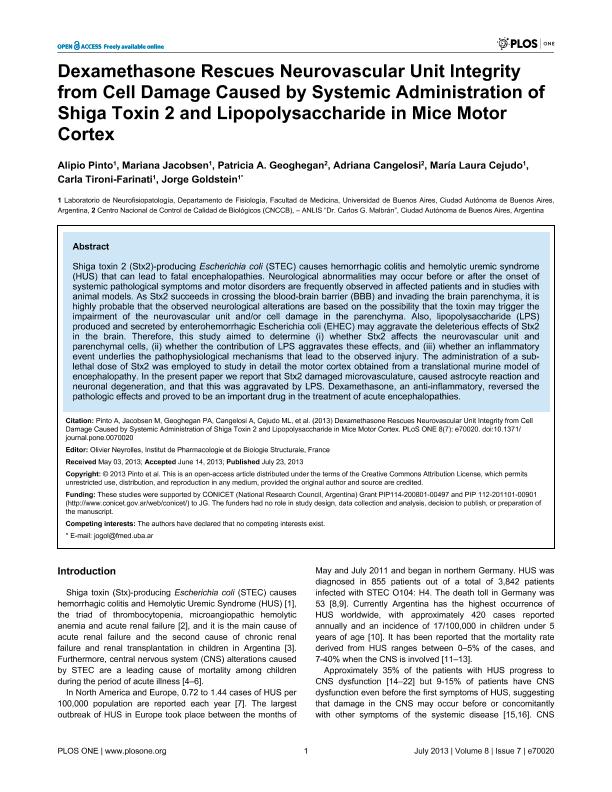Mostrar el registro sencillo del ítem
dc.contributor.author
Pinto, Alipio
dc.contributor.author
Jacobsen, Mariana Elena

dc.contributor.author
Geoghegan, Patricia

dc.contributor.author
Cangelosi, Adriana
dc.contributor.author
Cejudo, Maria Laura

dc.contributor.author
Tironi-Farinati, Carla
dc.contributor.author
Goldstein Raij, Jorge

dc.date.available
2015-07-23T20:43:46Z
dc.date.issued
2013-07
dc.identifier.citation
Pinto, Alipio; Jacobsen, Mariana Elena; Geoghegan, Patricia; Cangelosi, Adriana; Cejudo, Maria Laura; et al.; Dexamethasone Rescues Neurovascular Unit Integrity from Cell Damage Caused by Systemic Administration of Shiga Toxin 2 and Lipopolysaccharide in Mice Motor Cortex; Public Library of Science; Plos One; 8; 7; 7-2013; 1-14
dc.identifier.issn
1932-6203
dc.identifier.uri
http://hdl.handle.net/11336/1485
dc.description.abstract
Shiga toxin 2 (Stx2)-producing Escherichia coli (STEC) causes hemorrhagic colitis and hemolytic uremic syndrome (HUS) that can lead to fatal encephalopathies. Neurological abnormalities may occur before or after the onset of systemic pathological symptoms and motor disorders are frequently observed in affected patients and in studies with animal models. As Stx2 succeeds in crossing the blood-brain barrier (BBB) and invading the brain parenchyma, it is highly probable that the observed neurological alterations are based on the possibility that the toxin may trigger the impairment of the neurovascular unit and/or cell damage in the parenchyma. Also, lipopolysaccharide (LPS) produced and secreted by enterohemorrhagic Escherichia coli (EHEC) may aggravate the deleterious effects of Stx2 in the brain. Therefore, this study aimed to determine (i) whether Stx2 affects the neurovascular unit and parenchymal cells, (ii) whether the contribution of LPS aggravates these effects, and (iii) whether an inflammatory event underlies the pathophysiological mechanisms that lead to the observed injury. The administration of a sublethal dose of Stx2 was employed to study in detail the motor cortex obtained from a translational murine model of encephalopathy. In the present paper we report that Stx2 damaged microvasculature, caused astrocyte reaction and neuronal degeneration, and that this was aggravated by LPS. Dexamethasone, an anti-inflammatory, reversed the pathologic effects and proved to be an important drug in the treatment of acute encephalopathies.
dc.format
application/pdf
dc.language.iso
eng
dc.publisher
Public Library of Science

dc.rights
info:eu-repo/semantics/openAccess
dc.rights.uri
https://creativecommons.org/licenses/by-nc-sa/2.5/ar/
dc.subject
Shiga Toxin (Stx)-Producing Enterohemorrhagic Escherichia Coli Outbreaks
dc.subject
Lipopolysaccharide
dc.subject
Encephalopathy
dc.subject
Dexamethasone
dc.subject
Neurovascular Unit Dysfunction
dc.subject
Vascular Endothelial Growth Factor
dc.subject.classification
Biología Celular, Microbiología

dc.subject.classification
Ciencias Biológicas

dc.subject.classification
CIENCIAS NATURALES Y EXACTAS

dc.title
Dexamethasone Rescues Neurovascular Unit Integrity from Cell Damage Caused by Systemic Administration of Shiga Toxin 2 and Lipopolysaccharide in Mice Motor Cortex
dc.type
info:eu-repo/semantics/article
dc.type
info:ar-repo/semantics/artículo
dc.type
info:eu-repo/semantics/publishedVersion
dc.date.updated
2016-03-30 10:35:44.97925-03
dc.journal.volume
8
dc.journal.number
7
dc.journal.pagination
1-14
dc.journal.pais
Estados Unidos

dc.journal.ciudad
San Francisco
dc.description.fil
Fil: Pinto, Alipio. Universidad de Buenos Aires. Facultad de Medicina. Departamento de Ciencias Fisiológicas; Argentina
dc.description.fil
Fil: Jacobsen, Mariana Elena. Universidad de Buenos Aires. Facultad de Medicina. Departamento de Ciencias Fisiológicas; Argentina
dc.description.fil
Fil: Geoghegan, Patricia. Diección Nacional de Instituto de Investigación. Administración Nacional de Laboratorio e Instituto de Salud; Argentina
dc.description.fil
Fil: Cangelosi, Adriana. Diección Nacional de Instituto de Investigación. Administración Nacional de Laboratorio e Instituto de Salud; Argentina
dc.description.fil
Fil: Cejudo, Maria Laura. Universidad de Buenos Aires. Facultad de Medicina. Departamento de Ciencias Fisiológicas; Argentina
dc.description.fil
Fil: Tironi-Farinati, Carla. Universidad de Buenos Aires. Facultad de Medicina. Departamento de Ciencias Fisiológicas; Argentina
dc.description.fil
Fil: Goldstein Raij, Jorge. Universidad de Buenos Aires. Facultad de Medicina. Departamento de Ciencias Fisiológicas; Argentina. Consejo Nacional de Investigaciones Científicas y Técnicas. Oficina de Coordinación Administrativa Houssay; Argentina
dc.journal.title
Plos One

dc.relation.alternativeid
info:eu-repo/semantics/altIdentifier/url/http://journals.plos.org/plosone/article?id=10.1371/journal.pone.0070020
dc.relation.alternativeid
info:eu-repo/semantics/altIdentifier/doi/http://dx.doi.org/10.1371/journal.pone.0070020
Archivos asociados
